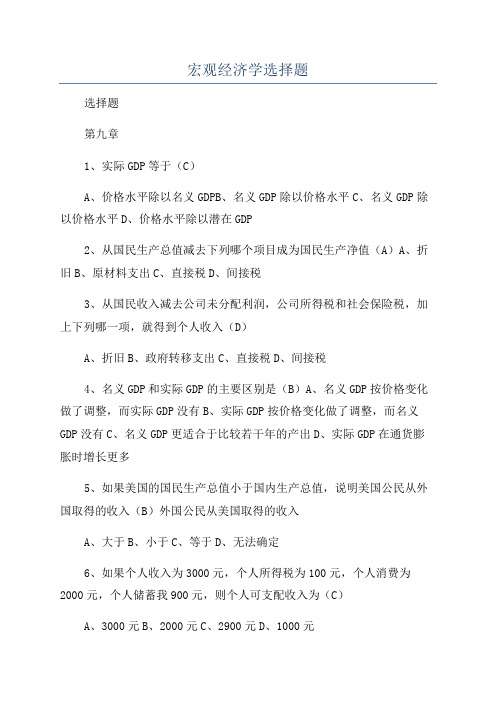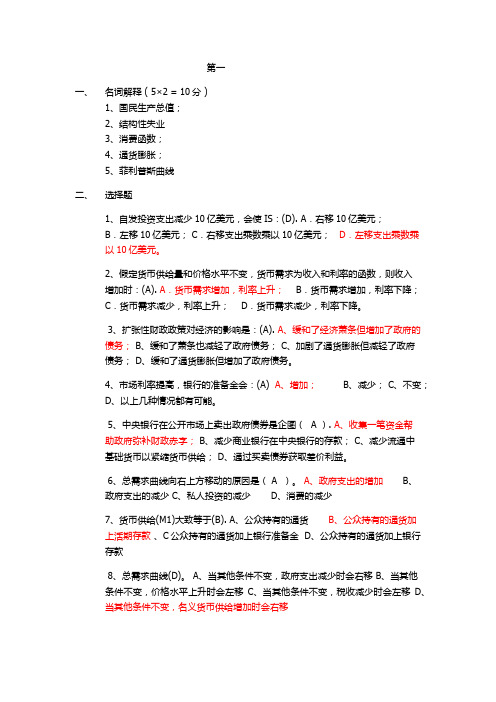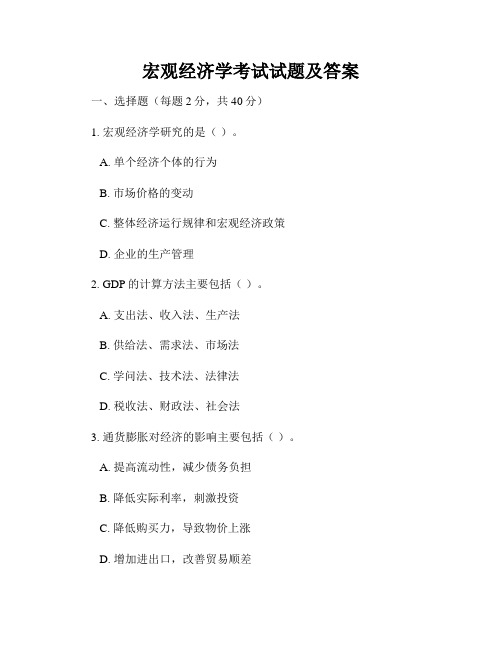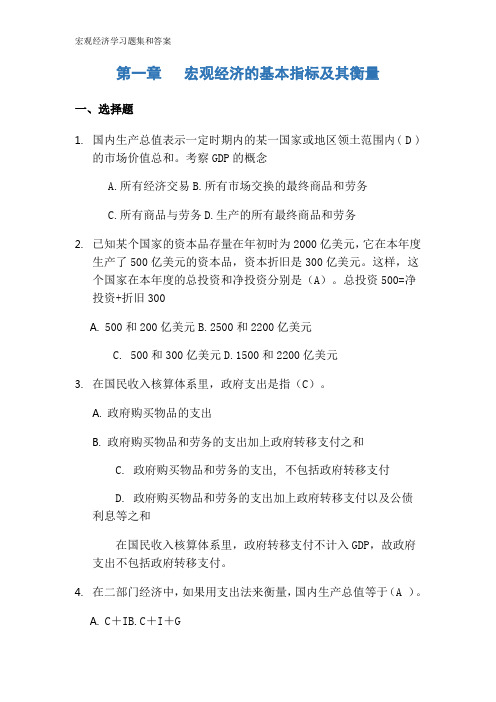宏观经济学选择题 题集 全
宏观经济学选择题大全与答案

选择80第一章第一81.国民生产总值(GNP)包括(A)47A.本国国民在本国和外国生产的最终产品的市场价值B.外国国民在本国和外国生产的最终产品的市场价值C.本国国民和外国国民在本国生产的最终产品的市场价值D.本国国民和外国国民在外国生产的最终产品的市场价值2.国内生产总值是下面哪一项的市场价值(D)29A.一年内一个经济中的所有交易B.一年内一个经济中交换的所有商品和劳务C.一年内一个经济中交换的所有最终商品和劳务D.一年内一个经济中生产的所有最终商品和劳务3.国内生产总值是指(C)29A.一国的所有国民在一特定时期内的总收入B.一国居民在一特定时期内生产的所有商品和服务的货币价值总和扣去折旧部分C.一国居民在一特定时期内生产的所有商品和服务的货币价值总和D.一国居民在一特定时期内销售的所有商品和服务的货币价值总和4.表示一国国民在一定时期内生产的所有最终产品和劳务的市场价值的总量指标是(A)47A.国民生产总值B.国内生产总值C.名义国民生产总值D.实际国民生产总值5.表示一个国家领土上居民在一定时期内生产的所有最终产品和劳务的市场价值的总量指标是(B)29A.国民生产总值B.国内生产总值C.名义国民生产总值D.实际国民生产总值6.在宏观经济学创立过程中起了决定作用的一部著作是(C)10A.亚当·斯密的《国富论》B.马歇尔的《经济学原理》C.凯恩斯的《通论》D.萨缪尔森的《经济学》7.宏观经济学的中心理论是(C)16A.价格决定理论B.工资决定理论C.国民收入决定理论D.汇率决定理论8.现代宏观经济学的创立者是(D)5A.亚当·斯密B.大卫·李嘉图C.马歇尔D.凯恩斯第二81.“面包是最终产品,而面粉是中间产品”,这一命题是(C)29A.一定是对的B.一定是不对的C.可能是对的,也可能是不对的D.在任何情况下都无法判断2.“苹果是中间产品”这一命题(C)29A.一定是对的B.一定是不对的C.可以是对的,也可以是错的D.以上三种说法全对3.当煤炭有多种用途时,作为最终产品的是(A)29A.家庭用于做饭和取暖B.餐馆用于做饭C.供热公司用于供应暖气D.化工厂作为原料4.在下列四种情况中应该计入当年国内生产总值的是(B)29A.用来生产面包的面粉B.居民用来自己食用的面粉C.饭店为居民提供面条所使用的面粉D.工业生产中所使用的面粉5.下面不列入国内生产总值核算的是(B)29A.出口到国外的一批货物B.政府给贫困家庭发放的一笔救济金C.经纪人为一座旧房买卖收取的一笔佣金D.保险公司收到一笔家庭财产保险费6.下列各项中计入国民生产总值的是(D)45A.购买一辆用过的旧自行车B.购买普通股票C.汽车制造厂买进10吨钢板D.银行向某企业收取一笔贷款利息7.在下列几种产品中应该计入国民生产总值的是(A)A. 当年生产的衣服B.去年生产而今年销售的衣服C.某人去年购买今年转售给他人的衣服D.别人赠送的衣服8.下列各项可被计入GDP的是(C)43A.家庭主妇的家务劳动B.拍卖毕加索画稿的收入C.晚上帮邻居照看孩子的收入D.从政府那里获得的困难补助收入第三81.用支出法计算国内生产总值(GDP)时,企业用于存货的支出属于(B)43A.消费 B.投资 C.政府购买 D.净出口2.在用支出法计算国内生产总值(GDP)时,本国国民购买私人住宅的支出属于(B)43A.消费 B.投资 C.政府购买 D.净出口3.在用支出法计算国民生产总值时,不属于投资的是(A)43A.通用汽车公司购买政府债券 B.通用汽车公司增加500辆汽车的存货C.通用汽车公司购买了一台机床 D.通用汽车公司建立了另一条新装配线4.从经济学意义上讲,以下各项不属于投资的是(A)43A.人们购买土地B.厂房增加C.企业存货的增加D.新住宅的增加5.经济学上的投资是指(D)43A.企业增加一笔存货B.建造一座住宅C.企业购买一台计算机D.以上都是6.用支出法核算GDP时,投资包括(C)43A.政府部门提供的诸如公路、桥梁等设施B.购买一种新发行的普通股C.年终比年初相比增加的存货量D.消费者购买但当年未消费完的产品7.按支出法,应计入国内总投资的项目是(C)43A.个人购买的小汽车B.个人购买的游艇C.个人购买的住房D.个人购买的股票8.下列各项属于投资的是(D)A.企业新建厂房B.建造一座住宅C.企业增加的存货D.以上都是第四81.支付给公务员的薪水属于(A)43A.政府购买B.转移支付C.税收D.消费2.下列不属于政府购买的是(B)43A.地方政府建立的三所中学B.政府给低收入人群的住房补贴C.政府订购一批军火D.政府给公务人员的工资3.在国民收入核算体系里,政府购买是指(C)43A.政府购买物品的支出B.政府购买物品和劳务的支出加上政府转移支付之和C.政府购买物品和劳务的支出,不包括政府转移支付D.政府购买物品的支出加上政府转移支付之和4.下面哪一种情况属于政府对居民户的转移支付(D)43A.政府为其公务员支付工资B.政府为购买飞机而进行的支付C.政府国防建设支出D.政府为失业工人提供的失业救济金5.净出口是指(A)44A.出口减进口B.出口加进口C.出口加政府转移支付D.进口减出口6.下面哪一项不是用要素收入法计算GDP时的一部分(D)45A.租金收入B.雇员报酬C.公司利润D.净出口7.使用收入法核算GDP时,下列各项中不必要的是(B)45A.工资、利息和租金B.净出口C.企业转移支付及企业间接税D.资本折旧8.下列说法中,不属于国民生产总值特征的是(A)29A.它是用实物量测度的B.它测度的是最终产品和劳务的价值C.它是流量D.它没有计入中间产品第五81.在四部门经济中,GDP是指下列哪一项的总和(B)44A.消费、净投资、政府购买和净出口B.消费、总投资、政府购买和净出口C.消费、总投资、政府购买和总出口D.消费、净投资、政府购买和总出口2.用支出法核算GDP不包括(C)44A.CB.IC.TrD.G3.在国民收入核算中,最重要的是核算(B)46A.国民收入B.国内生产总值C.国内生产净值D.个人收入4.在一般情况下,国民收入核算体系中数值最小的是 (C)47A. 国内生产净值B. 国民收入C.个人可支配收入D. 国民生产总值5.在一般情况下,国民收入核算体系中,数值最小的是(B)47A. NDPB. NIC. DPID. PI6.从国民生产总值减去下列项目成为国民生产净值(A)47A.折旧B.原材料支出C.直接税D.间接税7.国内生产总值和国内生产净值之间的差别是(C)47A.直接税B.间接税C.折旧D.政府津贴8.实际GDP等于(B)30A.GDP折算系数除以名义GDPB.名义GDP除以GDP折算系数C.名义GDP乘以GDP折算系数D.GDP折算系数乘以潜在GDP第六81.一国的国内生产总值小于国民生产总值,说明该国公民从外国取得的收入与外国公民从该国取得的收入的关系是(A)46A.大于 B.小于 C.等于 D.不能确定2.一国从国外取得的净要素收入大于零,说明(A)46A.GNP>GDPB.GNP=GDPC.GNP<GDPD.GNP与GDP不可比3.两部门经济国民收入恒等的条件(公式)是(A)48A.C+I=C+SB.I+G=S+XC.I+G=S+TD.I+G+(X-M)=S+T+Kr4.在两部门经济中,决定均衡产出的条件:I=S,表示(B)48A.实际投资等于实际储蓄B.计划投资等于计划储蓄C.实际投资等于计划储蓄D.计划投资等于实际储蓄5.在两部门经济中,均衡发生时(C)48A.实际储蓄等于实际投资B.实际的消费加实际的投资等于产出值C.计划储蓄等于计划投资D.总支出等于企业部门的收入6.三部门经济是指(B)48A.企业、家庭、银行B.企业、政府、家庭C.政府、家庭、外国消费者D.政府、企业、银行7.三部门经济国民收入恒等的条件(公式)是(C)48A.C+I=C+SB.I+G=S+XC.I+G=S+TD.I+G+(X-M)=S+T+Kr8.四部门经济国民收入恒等的条件(公式)是(D)50A.C+I=C+SB.I+G=S+XC.I+G=S+TD.I+G+(X-M)=S+T+Kr第七81.根据消费函数,引起消费增加的因素是(D)61A.边际消费倾向B.边际储蓄倾向C.国家的税收D.国民收入2.消费函数的斜率取决于(A)60A.边际消费倾向B.与可支配收入无关的消费总量C.平均消费倾向D.由于收入变化引起的投资量3.消费是下列哪个变量的递增函数(B)61A.物价 B.收入 C.利率 D.汇率4.若平均消费倾向为一常数,则消费函数将是(B)61A.在纵轴上有一正截距的直线B.通过原点的一条直线C.一条相对于横轴上凸的曲线D.一条相对于横轴下凹的曲线1.边际消费倾向与边际储蓄倾向之和(B)64A.大于1B.等于1C.小于1D.等于02.边际储蓄倾向等于(C )64A.边际消费倾向B.1+边际消费倾向C.1-边际消费倾向D.边际消费倾向的交互3.如果边际储蓄倾向为负,则(A)64A.边际消费倾向大于1B.边际消费倾向小于1C.边际消费倾向等于1D.边际消费倾向与边际储蓄倾向之和小于14.关于边际消费倾向和边际储蓄倾向关系,下列叙述正确的是(C)64A.边际消费倾向大B.边际消费倾向小C.两者之和等于1D.不能确定第八81.关于APC和APS之间的关系,下面哪种说法是正确的(D)64A.APC>APSB.APC<APSC.APC=APSD.APC+APS=12.根据APC、APS、MPC和MPS之间的关系,下面哪种说法是正确的(C)64A.如果MPC增加,那么MPS也增加B.MPC+APC=1C.MPC+MPS=APC+APSD.MPC+MPS>APC+AP3.根据APC和MPC之间的关系,下面哪种说法是正确的(A)61A.APC>MPCB.APC<MPCC.APC=MPCD.不确定4.根据APS和MPS之间的关系,下面哪种说法是正确的(B)64A.APS>MPSB.APS<MPSC.APS=MPSD.不确定5.某家庭在收入为0时,消费支出为2000元,后来收入升至6000元,消费支出亦升至6000元,则该家庭的边际消费倾向是(B)62A.3/4B.2/3C.1/3D.16.投资乘数等于(A)74A.收入变化除以投资变化B.投资变化除以收入变化C.边际消费倾向的倒数D.(1-MPS)的倒数7.税收乘数和转移支付乘数的最显著区别是(B)82A.税收乘数总比转移支付乘数小1B.前者为负,而后者为正C.两者互为相反数D.后者是负的,而前者为正8.三部门经济里,投资乘数与政府购买乘数的关系(C)82A.大于B.小于C.相等D.不确定第九81.两部门经济中,投资乘数与(A)74A.MPC同方向变动B.MPC反方向变动C.MPS同方向变动D.以上都不2.在三部门经济中,影响政府支出乘数大小的因素是(A)81A.边际消费倾向和边际储蓄倾向B.边际消费倾向和边际利率C.边际消费倾向和边际进口倾向D.边际消费倾向和边际税率3.以下四种情况,投资乘数最大的是(C)74A.边际消费倾向为0.6B.边际消费倾向为0.4C.边际储蓄倾向为0.1D.边际储蓄倾向为0.34.下列哪种情况不会引起国民收入水平的上升(B)82A.增加投资B.增加税收C.增加转移支付D.减少税收5.政府支出的增加与政府转移支付的减少相同时,收入水平会(B)A.不变B.增加C.减少D.不相关6.政府在预算平衡条件下增加支出会使总产出(A)83A.增加B.减少C.不变D.不确定7.下列哪种情况可能使国民收入增加的最多(A)82A.政府对高速公路的抚养开支增加250亿美元B.政府转移支付增加250亿美元C.政府增加购买250亿元,同时增加税收250亿元D.个人所得税减少250亿美元8.下列哪一项财政政策将导致国民收入水平有最大增长(A)82A.政府增加购买50亿元商品和劳务B.政府增加购买50亿元,同时增加税收50亿元C.税收减少50亿元D.政府支出增加50亿元,其中30亿元由增加的税收弥补第十81.关于投资与利率的关系,以下判断正确的是(B)101A.投资是利率的增函数B.投资是利率的减函数C.投资与利率是非相关关系D.以上判断都不正确2.当投资支出与利率负相关时,产品市场上的均衡收入(B)101A.与利息率不相关B.与利率负相关C.与利率正相关D.随利率下降而下降3.IS曲线表示(C)103A.当产品市场达到均衡时,国民收入和物价水平之间的关系B.当货币市场达到均衡时,国民收入和物价水平之间的关系C.当产品市场达到均衡时,国民收入和利率之间的关系D.当货币市场达到均衡时,国民收入和利率之间的关系4.IS曲线为Y=500-3000R,下列哪一个利率和收入水平的组合在IS曲线上(A)103A.R=0.02, Y=440B.R=0.03, Y=400C.R=0.10, Y=210D.R=0.15, Y=2005.如果投资对利率变的很敏感,那么(B)104A.IS 曲线将变的更陡峭B.IS 曲线将变的更平坦C.LM 曲线将变的更陡峭D.LM 曲线将变的更平坦6.在其它因素不变情况下,自发性投资增加10亿美元,IS曲线将(C)105A.右移10亿美元B.左移10亿美元C.右移支出乘数乘以10亿美元D.左移支出乘数乘以10亿美元7.如果净税收增加10亿美元,会使IS(B)105A.右移税收乘数乘以10亿美元B.左移税收乘数乘以10亿美元C.右移支出乘数乘以10亿美元D.左移支出乘数乘以10亿美元8.如果政府支出有一增加(C)105A.对IS曲线无影响B.IS曲线向左移动C.IS曲线向右移动D.以上说法都不对第十一81.根据凯恩斯理论,利率水平主要取决于(B)106A.供给B.货币需求与货币供给C.储蓄D.储蓄与投资2.根据凯恩斯理论,利率水平取决于(B)106A.货币需求B.货币需求和货币供给C.储蓄D.储蓄与投资3.按照凯恩斯货币需求观点,人们持有货币是由于(D)98A.交易性货币需求动机B.预防性货币需求动机C.投机性货币需求动机D.以上货币需求动机都正确4.影响货币需求的主要因素有(C)98A.交易性货币需求B.谨慎性货币需求C.投机性货币需求D.其它5.对利率变动最敏感的是(C)98A.货币的交易需求B.货币的谨慎需求C.货币的投机需求D.三种需求相同6.当利率降得很低时,人们购买债券的风险(B)99A.将变得很小B.将变得很大C.不确定D.不变7.在凯恩斯的货币需求函数中,当利率上升时(D)98A.货币的交易需求将增加B.货币的交易需求将减少C.货币的投机需求将增加D.货币的投机需求将减少8.如果其他因素既定不变,利率降低,将引起货币的(C)99A.交易需求量增加B.投机需求量增加C.投机需求量减少D.交易需求量减少第十二81.货币需求(B)99A.与收入水平成正比,与利率成正比B.与收入水平成正比,与利率成反比C.与收入水平成反比,与利率成正比D.与收入水平成反比,与利率成反比2.按照凯恩斯的货币理论,如果利率上升,货币需求将(C)99A.不变B.受影响,但不能确定是上升还是下降C.下降D.上升3.假定货币供给量不变,货币的交易需求和预防需求增加将导致货币的投机需求(C)107A.增加B.不变C.减少D.不确定4.货币供给一定,收入下降会使(C)107A.利率上升,因为投机需求和交易需求都下降B.利率上升, 因为投机需求和交易需求都上升C.利率下降,因为投机需求会上升,交易需求会下降D.利率下降,因为投机需求会下降,交易需求会上升5.假定货币供给量和价格水平不变,货币需求为收入和利率的函数,则收入增加时(A)107A.货币需求增加,利率上升B.货币需求增加,利率下降C.货币需求减少,利率上升D.货币需求减少,利率下降6.根据简单凯恩斯模型,货币需求取决于(A)106A.实际收入和实际利率B.名义收入和实际利率C.名义收入和名义利率D.实际收入和名义利率7.若LM方程为Y=750+2000R,当货币需求与货币供给相等时候利率和收入为(C)107A.R=10%, Y=750B.R=10%, Y=800C.R=10%, Y=950D.R=10%, Y=9008.价格水平上升导致(A)109A.实际货币供给下降,LM曲线左移B.实际货币供给下降,LM曲线右移C.实际货币供给上升,LM曲线左移D.实际货币供给上升,LM曲线右移第十三81.引起LM曲线向右方移动所原因是(D)109A.实际国民生产总值增加B.名义货币供给与物价水平同比例增加C.名义货币供给不变,物价水平上升D.名义货币供给不变,物价水平下降2.假定其他条件不变,货币供给量增加将使(D)108A.IS曲线向左下方移动B.IS曲线向右上方移动C.LM曲线向左上方移动D.LM曲线向右下方移动3.假定货币需求为L=ky-hr,货币供给增加10亿美元而其他条件不变,则会使LM(C)118A.右移10亿美元B.右移k乘以10亿美元C.右移10亿美元除以k(即10÷k)D.右移k除以10亿美元(即k÷10)4.在LM曲线不变的情况下,政府支出增加将会导致(A)112A.均衡收入与利率同时上升B.均衡收入与利率同时下降C.均衡收入增加,均衡利率下降D.均衡收入减少,均衡利率上升5.在IS曲线不变的情况下,货币供给量增加将导致(D)112A.均衡利率上升,均衡GDP上升B.均衡利率下降,均衡GDP下降C.均衡利率上升,均衡GDP下降D.均衡利率下降,均衡GDP上升6.LM曲线成垂直状的区域被称为(A)109A.古典区域B.凯恩斯区域C.中间区域D.以上都不是7.LM曲线水平状的区域被称为(B)109A.古典区域B.凯恩斯区域C.中间区域D.以上都不是8.利率和收入的组合点出现在IS曲线右上方,LM曲线的左上方区域中,则表示(A)111A.投资小于储蓄且货币需求小于货币供给B.投资小于储蓄且货币需求大于货币供给C.投资大于储蓄且货币需求小于货币供给D.投资大于储蓄且货币需求大于货币供给第十四81.在下述何种情况下,挤出效应可能最大的是(D)168A.货币需求对利率具有敏感性,私人部门支出对利率也有敏感性B.货币需求对利率具有敏感性,私人支出对利率没有敏感性C.货币需求缺乏利率敏感性,私人支出也缺乏利率敏感性D.货币需求缺乏利率敏感性,私人支出很有利率敏感性2.在下列哪种情况下,由IS-LM模型,财政政策更有效(D)150AA.边际消费倾向小,货币需求对利率的反应弹性较大B.边际消费倾向大,货币需求对利率的反应弹性较大C.投资对利率的反应灵敏,货币需求对利率的反应弹性较大D.投资对利率的反应不灵敏,货币需求对利率的反应程度较小3.“挤出效应”发生于(C)168A.货币供给减少使利率提高,挤出了对利率敏感的私人部门支出B.私人部门增税,减少了私人部门的可支配收入和支出C.所得税的减少,提高了利率,挤出了对利率敏感的私人部门支出D.政府支出减少,引起消费支出下降4.不存在挤出效应的条件是(C)148A.实际货币需求总体上对利率的变动不会做出反应B.实际货币供给总体上对利率的变动不会做出反应C.投资需求总体上对利率的变动不会做出反应D.投资需求总体上对实际国民生产总值的变动不会做出反应5.如果投资对利率是完全无弹性的,货币供给的增加将(B)169A.收入不变,但利率降低B.没有挤出,利率降低的同时收入亦会增加很多C.利率不变,但收入增加很多D.利率和收入水平均有提高6.货币供给增加使 LM右移△ M•( 1/k),若要均衡收入变动接近于LM的移动量,则必须是(C)168A.LM陡峭,IS也陡峭B.LM和IS一样平缓C.LM陡峭而IS平缓D.LM平缓而IS陡峭7.货币供给增加使 LM 曲线右移,若要使均衡收入变动接近于 LM 曲线的移动量,则必须(C)150A.LM 曲线陡峭,IS 曲线也陡峭B.LM 曲线与 IS 曲线一样平缓C.LM 曲线陡峭,而 IS 曲线平缓D.LM 曲线平缓,而 IS 曲线陡峭8.政府支出增加使IS右移kg.△G(kg是政府支出乘数),若要均衡收入的变动量接近于IS 的移动量,则必须是(D)168A.LM曲线和IS曲线一样陡峭B. LM曲线垂直而IS曲线陡峭C.LM曲线和IS曲线一样平坦D. LM曲线平坦而IS曲线陡峭第十五81.政府购买增加使IS曲线右移,若要均衡收入变动接近于IS曲线的移动量,则必须(A)149A.LM曲线平缓,IS曲线陡峭B.LM曲线垂直,IS曲线陡峭C.LM曲线和IS曲线一样平缓D.LM曲线陡峭,IS曲线平缓2.IS曲线斜率不变,LM曲线斜率越小,则财政政策作用效果(A)149A.越大B.越小C.零D.为负3.在IS曲线不变的情况下,LM曲线的弹性大,则(B)150A.采取财政政策的效果好B.采取货币政策的效果好C.采取财政政策与货币政策的效果一样好D.无法确定4.下列哪种情况中增加货币供给不会影响均衡收入(C)168A.LM陡峭而IS平缓B.LM垂直而IS陡峭C.LM平缓而IS垂直D.LM和IS一样平缓5.货币供给的变动如果对均衡收入有更大的影响,可能是因为(A)169A.私人部门的支出对利率更敏感B.私人部门的支出对利率不敏感C.支出乘数较小D.货币需求对利率更敏感6.若同时使用紧缩性的财政政策和紧缩性的货币政策,其经济后果可能是(C)169A.利率上升,产出变化不确定B.利率下降,产出变化不确定C.产出减少,利率变化不确定D.产出增加,利率变化不确定7.假定IS曲线和LM曲线的交点所表示的均衡国民收入低于充分就业的国民收入。
宏观经济学试卷试题题库及答案

宏观经济学试卷试题题库及答案《宏观经济学》试题一一、单项选择题1、宏观经济学的中心理论是()A、价格决定理论;B、工资决定理论;C、国民收入决定理论;D、汇率决定理论。
2、表示一国在一定时期内生产的所有最终产品和劳务的市场价值的总量指标是()A、国民生产总值;B、国内生产总值;C、名义国民生产总值;D、实际国民生产总值。
3、GNP核算中的劳务包括()A、工人劳动;B、农民劳动;C、工程师劳动;D、保险业服务。
4、实际GDP等于()A、价格水平除以名义GDP;B、名义GDP除以价格水平;C、名义GDP乘以价格水平;D、价格水平乘以潜在GDP。
5、从国民生产总值减下列项目成为国民生产净值()A、折旧;B、原材料支出;C、直接税;D、间接税。
6、从国民生产净值减下列项目在为国民收入()A、折旧;B、原材料支出;C、直接税;D、间接税。
二、判断题1、百姓生产总值中的最终产品是指有形的物质产品。
()2、今年建成并出售的房屋和去年建成而在今年出售的房屋都应计入今年的国民生产总值。
()3、同样的打扮,在生产中作为工作服就是中间产品,而在日常糊口中穿就是最终产品。
()4、百姓生产总值一定大于国内生产总值。
()5、居民购房支出属于个人消费支出。
()6、从理论上讲,按支出法、收入法和部门法所计算出的国民生产总值是一致的。
()7、所谓净出口是指出口减进口。
()8、在三部门经济中如果用支出法来计算,GNP等于消费+投资+税收。
()三、简答题1、比较实际国民生产总值与名义国民生产总值。
2、比较百姓生产总值与人均百姓生产总值。
3、为什么住房建筑支出作为投资支出的一部分?4、假定A为B提供服务应得报酬400美元,B为A提供服务应得报酬300美元,AB商定相互抵消300美元,结果A只收B100美元。
应如何计入GNP?(一)答案一、C、A、D、B、A、D;二、错、错、对、错、错、对、对、错;三、1、实际国民生产总值与名义国民生产总值的区别在于计算时所用的价格不同。
宏观经济学选择题

宏观经济学选择题选择题第九章1、实际GDP等于(C)A、价格水平除以名义GDPB、名义GDP除以价格水平C、名义GDP除以价格水平D、价格水平除以潜在GDP2、从国民生产总值减去下列哪个项目成为国民生产净值(A)A、折旧B、原材料支出C、直接税D、间接税3、从国民收入减去公司未分配利润,公司所得税和社会保险税,加上下列哪一项,就得到个人收入(D)A、折旧B、政府转移支出C、直接税D、间接税4、名义GDP和实际GDP的主要区别是(B)A、名义GDP按价格变化做了调整,而实际GDP没有B、实际GDP按价格变化做了调整,而名义GDP没有C、名义GDP更适合于比较若干年的产出D、实际GDP在通货膨胀时增长更多5、如果美国的国民生产总值小于国内生产总值,说明美国公民从外国取得的收入(B)外国公民从美国取得的收入A、大于B、小于C、等于D、无法确定6、如果个人收入为3000元,个人所得税为100元,个人消费为2000元,个人储蓄我900元,则个人可支配收入为(C)A、3000元B、2000元C、2900元D、1000元7、假设2022年为当年,2022年的CPI为120,再假设2022年的CPI为100,则2022年通货膨胀率为()A、12%B、16.7%C、20%D、26.7%8、失业率是指(A)A、失业人数占劳动力总数的百分比B、失业人数占整个国家人口数的百分比C、失业人数占就业人口数的百分比D、失业人数占劳动力资源的百分比9、某个研究生毕业后未能立即找到工作,属于()A、摩擦性失业B、结构性失业C、周期性失业D、季节性失业10、2022年国际经济危机所造成的失业属于()A、摩擦性失业B、结构性失业C、周期性失业D、永久性失业10、某个建筑工人因为建筑业不景气而失去工作,这种失业属于()A、摩擦性失业B、结构性失业C、周期性失业D、永久性失业12、在支出法下统计,不计入GDP的是()A、理发支出B、购房支出C、购买股票的支出D、外国人购买出口产品的支出13、在支出法下统计,下列哪一项对GDP的计算不产生影响()A、购买食品的支出B、购买股票的支出C、购买进口食品的支出D、购房支出14、设某国的代表性商品为甲、乙、丙三种,2000年它们的价格分别为2、5、10美元,2022年分别为6、10、30美元,它们在消费支出额中所占的比重分别为30%、20%和50%,2000年作为基年的价格指数为100,则2022年的CPI约为()A、271B、560C、284D、80015、如果某经济体2022年的名义GDP为300亿,经计算得到的该年实际GDP为200亿,基年的GDP平减指数为100,那么2022年的GDP平减指数为()A、150B、660C、220D、25016、下列哪一说法是正确的()A、NNP中包含了折旧B、NI中包含了折旧C、PI中未包含公司待分配利润D、PI中未包含个人所得税17、下列哪一项目应计入GDP()A、政府补贴B、债券购买额C、旧房子的转让D、股票交易印花税18、下列哪一项不应计入GDP中()A、某公司公开发行10亿股股票,每股10元B、证券交易所对股票交易征收1‰的印花税C、一位学生课余时间的家教收入,年收入为3500元D、某人花费2000元购买各种零配器件,自己装配了一台家用电脑19、如果某经济体2022年的名义GDP为400亿,经计算得到的该年实际GDP为200亿,基年的GDP平减指数为100,那么2022你那的GDP平减指数为()A、150B、660C、200D、25020、1955年的GDP以当年价计算为3060亿元,1965年的GDP以当年价计算为6760亿元,价格指数1955年为91,1965年为111,那么,1965年与1955年的GDP实际值相比()A、保持不变B、增长约40%C、增长约70%D、增长约90%21、下列哪一项应计入GDP中()A、面包厂购买的面粉B、购买40股股票C、家庭主妇购买的面粉D、购买政府债券22、所谓净出口是指()A、出口减进口B、进口减出口C、出口加进口D、GDP减出口23、在三部门经济中,如果用支出法来衡量,GDP等于()A、消费+投资B、消费+投资+政府支出C、消费+投资+政府支出+净出口D、消费+投资+净出口24、国民生产总值与国民生产净值之间的区别是()A、直接税B、折旧C、间接税D、净出口25、按最终使用者类型,将最终产品和劳务的市场价值加总起来计算GDP的方法是()A、支出法B、收入法C、生产法D、增加值法26、今年的名义GDP增加了,说明()A、今年物价上涨了B、今年的物价和产出都增加了C、今年的产出增加了D、不能确定27、下列项目那一项计入GDP()A、政府转移支付B、购买一辆用过的车C、购买普通股股票D、企业支付的贷款利息28、某个的GNP大于GDP,说明该国居民从外国得到的收入与外国从该国获得的收入相比关系()A、大于B、小于C、等于D、无法判断29、假设2022年为当年,2022年的CPI为110在假设2022年的CPI 为100,则2022年的通货膨胀率为()A、12%B、16.7%C、10%D、26.7%30、某个本科生毕业后未能立即找到工作,属于()A、周期性失业B、结构性失业C、摩擦性失业D、季节性失业31、由于一国发生经济危机所造成的失业属于()A、摩擦性失业B、结构性失业C、周期性失业D、永久性失业32、某个房产中介经纪人因为房地产产业不景气而失业,这种失业属于()A、摩擦性失业B、结构性失业C、周期性失业D、永久性失业33、如果个人收入为3000元,个人所得税为200元,个人消费为2200元,则个人可支配收入为()A、3000元B、2200元C、2800元D、800元34、“面粉是中间产品”这一命题()A、一定是对的B、一定是不对的C、可能是对的,也可能是不对的D、以上三种说法全对第十章1、短期消费曲线的斜率决定于()A、MPC和APCB、MPC和APSC、MPC和MPSD、APC和MPS2、相对收入假说的消费理论表面()A、MPC可能会提高B、MPC可能会不变C、MPC会下降D、人们的实际收入决定了消费水平3、理论上,投资乘数效应的产生过程中,下列哪一项是不存在的()A、出事投资会全部转化为收入B、消费增量不断趋于减少C、收入增量不断趋于增加D、生产消费平的厂商没有库存品4、下列哪一项会改变理论上计算出的投资乘数值()A、新增消费用于购买不同的产品B、边际消费倾向接近1C、新增消费不断地促进收入的增加D、新增收入中用于消费的比重不断下降5、下列哪一项陈诉不符合投资乘数理论()A、投资的减少会引起国民收入的倍数减少B、投资乘数的计算以边际消费倾向递减为假定前提C、投资乘数与边际消费倾向正相关D、消费增量最终趋近于零6、假设消费函数C=100+0.8Y,投资I=50,政府购买支出G=200,政府转移支付Tr=62.5,定量税T=250,那么平衡预算乘数为()A、4B、-4C、5D、17、下述哪种消费函数论最不易用以说明申请较多贷款来购房的行为()A、相对收入B、绝对收入C、生命周期D、持久收入8、消费曲线的斜率与以下哪一项直接相关()A、平均消费倾向B、平均储蓄倾向C、边际储蓄倾向D、需求的收入弹性9、下列哪一项不符合投资乘数理论()A、I的减少会引起Y的倍数减少B、投资乘数的计算以MPC递减为假定前提C、投资乘数与MPC正相关D、△C最终趋近与零10、就同一时期的某经济体而言,其乘数之间一般存在如下关系()A、税收乘数大于政府购买乘数B、投资乘数大于转移支付乘数C、转移支付乘数大于投资乘数D、税收乘数大于转移支付乘数11、MPC递减意味着()A、MPS递减B、消费额减少C、APS递减D、产品滞销的可能性递增12、如果MPS为负,那么()A、MPC大于1B、MPC等于1C、MPC小于1D、MPC与MPS之和小于113、恒久收入消费理论认为,下述哪一项包含的两个变量之间存在稳定的关联性()A、暂时收入与恒久收入B、暂时消费与恒久消费C、恒久收入与恒久消费D、暂时收入与暂时消费14、凯恩斯主义关于均衡郭明收入决定的基本原理是()A、总供给水平决定均衡国民收入水平B、总需求水平决定均衡国民收入水平C、消费水平决定均衡国民收入水平D、总供给水平和总收入水平决定均衡国民收入水平15、在两部门经济中,实现均衡产出或均衡郭明收入的条件是()A、总支出的企业部门的收入B、实际消费加实际投资等于产出值C、计划储蓄等于计划投资D、实际储蓄等于实际投资16、一个家庭当其收入为零时,消费支出为2000元,而当其收入为6000元时,其消费支出为6000元,在图形中,消费和收入之间成一条直线,则其边际消费倾向为()A、2/3B、3/4C、4/5D、117、边际消费倾向和边际储蓄倾向之间的关系是()A、它们的和等于0B、它们的和等于1C、它们之间的比率表示平均消费倾向D、它们之间的比率表示平均储蓄倾向18、如果消费函数为一条向右上方倾斜的直线,则边际消费倾向()A、递减B、不变C、递增D、不确定19、如果消费函数为一条向右上方倾斜的直线,则平均消费倾向()A、递减B、不变C、递增D、不确定20、边际消费倾向小于1,则意味着当前可支配收入的增加将使意愿的消费()A、增加,但幅度小于可支配收入的增加幅度B、增加,但幅度等于可支配收入的增加幅度C、有所下降,这是由于收入的增加会增加储蓄D、保持不变,这是由于边际储蓄倾向同样小于121、在简单的凯恩斯模型中,若消费函数为C=100+0.9Y,则投资函数为()A、0.9B、5C、10D、0.122、在简单的凯恩斯模型中,若消费函数为C=100+0.2Y,则投资函数为()A、0.9B、5C、1.25D、0.323、在简单的凯恩斯模型中,若消费函数为C=100+0.4Y,则投资函数为()A、0.9B、5C、10D、1.6724、在简单的凯恩斯模型中,若消费函数为C=100+0.5Y,则投资函数为()A、0.9B、2C、10D、0.125、在简单的凯恩斯模型中,若消费函数为C=100+0.6Y,则投资函数为()A、0.9B、5C、10D、2.526、利率和投资量之间存在的关系是()A、利率越高,投资量越小B、利率越高,投资量越大C、利率与投资量之间的关系随经济形势的变化而变化D、利率与投资量之间不存在关系27、以下关于投资q理论,表述正确的是()A、q理论说明股票价格上升时,投资会相应减少B、q小于1,说明买旧的企业比新建更便宜,社会上不会有这方面的新投资C、q大于1,说明买旧的企业比新建更便宜,社会上不会有这方面的新投资D、q理论反映了资本的前期报酬率与当期报酬率之间的关系28、假设消费函数C=100+0.8Y,投资I=50,均衡收入为()A、700B、750C、50D、80029、假设消费函数C=100+0.8Y,投资I=50,均衡收入为()A、700B、750C、50D、80030、假设消费函数C=100+0.8Y,投资I=50,均衡收入为()A、700B、750C、50D、80031、在三部门经济中,已知消费函数为C=100+0.9Y,Yd为可支配收入,投资I=300,政府购买G=160,税收T=0.2Y,那么均衡的国民收入水平是()A、1000B、15000C、2000D、250032、在三部门经济中,已知消费函数为C=100+0.9Y,Yd为可支配收入,投资I=300,政府购买G=160,税收T=0.2Y,那么政府购买乘数为()A、25.7B、10C、5D、30033、假设消费函数C=100+0.8Y,投资I=50,政府购买支出G=200,政府转移支付Tr=62.5,定量税T=250,那么投资乘数为()A、5B、-5C、4D、-434、假设消费函数C=100+0.8Y,投资I=50,政府购买支出G=200,政府转移支付Tr=62.5,定量税T=250,那么政府购买乘数为()A、4B、-4C、5D、135、假设消费函数C=100+0.8Y,投资I=50,政府购买支出G=200,政府转移支付Tr=62.5,定量税T=250,那么政府购买乘数为()A、4B、-4C、5D、136、假设消费函数C=100+0.8Y,投资I=50,政府购买支出G=200,政府转移支付Tr=62.5,定量税T=250,那么税收乘数为()A、4B、-4C、5D、1第十一章1、IS曲线上的每一点都表示()A、使投资等于储蓄的均衡货币额B、产品市场投资等于储蓄时收入与利率的混合C、产品市场与货币市场都均衡时的收入与利率的组合D、货币市场的货币需求等于货币供给时的均衡货币额2、在其他条件不变的情况下,政府购买支出增加就会使IS曲线()A、向左移动B、向右移动C、保持不变D、发生移动,但方向不一定3、在其他条件不变的情况下,投资需求增加就会使IS曲线()A、向左移动B、向左移动,但均衡不变C、保持不变D、向右移动,但均衡不变4、按凯恩斯的货币需求理论,利率上升,货币需求将()A、增加B、减少C、不变D、可能增加,也可减少5、LM曲线表示()A、货币市场均衡时,收入与利率之间同方向的变动关系B、货币市场均衡时,收入与利率之间反方向的变动关系C、产品市场均衡时,收入与利率之间同方向的变动关系D、产品市场均衡时,收入与利率之间反方向的变动关系6、假定货币供给量和价格水平不变,货币需求为收入和利率的函数,则收入增加时()A、货币需求增加,利率上升B、货币需求增加,利率下降C、货币需求减少,利率上升D、货币需求减少,利率下降7、IS曲线上的任何一点所代表的下述哪个组合会使产品市场达到均衡()A、投资与储蓄B、政府购买与税收C、国民收入与利率D、出口与进口8、投资对利率变动的敏感程度提高会使IS曲线()A、向右移动B、向左移动C、斜率的绝对值变小D、斜率的绝对值变大9、边际消费倾向变小会使IS曲线()A、斜率的绝对值趋大B、斜率的绝对值趋小C、向右移动D、向左移动10、货币需求对利率变动的敏感程度降低会使LM曲线()A、向左移动B、向右移动C、斜率变小D、斜率变大11、收入对货币需求的影响增强会使LM曲线()B、向左移动B、向右移动C、斜率变大D、斜率变小12、IS曲线与LM曲线在平面几何图形上将空间氛围上,下,左,右四个区域,左边区域中()A、IMB、I>S及LS及L>MD、I13、税收减少会使IS曲线()A、斜率的绝对值变大B、斜率的绝对值变小C、右移D、左移14、将货币的投机需求视作下列哪一变量的函数()A、利率B、投资C、收入D、准备金率15、税收增加会使IS曲线()A、斜率的绝对值变大B、斜率的绝对值变小C、右移D、左移16、货币需求对收入变动的敏感度降低会使LM曲线()A、更平坦B、更陡峭C、右移D、左移17、物价总水平的降低会使LM曲线()A、左移B、右移C、更平坦D、更陡峭18、IS曲线是哪两个变量的组合关系的轨迹()A、投资与储蓄B、利率与投资C、利率与储蓄D、利率与国民收入19、政府支出的增加会使IS曲线()A、右移B、左移C、斜率的绝对值变大D、斜率的绝对值变小20、货币供给减少会使LM曲线()A、右移B、左移C、斜率变小D、斜率变大15、一般将货币的投机需求视作下列哪一变量的函数()A、利率B、投资C、收入D、准备金率16、下列哪一项会使IS曲线更为陡峭()A、政府转移支付提高B、边际消费倾向提C、税率提高D、政府购买增加17、如果货币市场均衡方程为r=kY/h-M/h,则引致LM曲线变得平坦是由于()A、k变小,h变大B、k变大,h变小C、k和h同比例变大D、k和h同比例变小18、当投资支出与利率负相关时,产品市场上的均衡收入()A、与利率不相关B、与利率正相关C、与利率负相关D、与利率的关系不稳定19、利率和收入点出现在IS曲线右上方,LM曲线的右下方区域中,则表示()A、投资小于储蓄,且货币需求小于货币供给B、投资小于储蓄,且货币需求大于货币供给C、投资大于储蓄,且货币需求大于货币供给D、投资大于储蓄,且货币需求小于货币供给20、边际消费倾向变大会使IS曲线()A、斜率的绝对值趋大B、斜率的绝对值趋小C、向右移动D、向左移动21、投资对利率变动的敏感程度降低会使IS曲线()A、向右移动B、向左移动C、斜率的绝对值趋大D、斜率的绝对值趋小22、已知实际货币供应量m=300,货币需求量L=o.2Y-6r,则LM曲线为()A、y=25r+1500B、y=5r+0.2C、y=2r+15D、y=25r+30023、假设一个只有家庭和企业两个部门的经济中,消费C=100+0.8Y,投资I=150-600r,则IS曲线为()A、y=1250-3000rB、y=1250+3000rC、y=1250r-3000D、y=1250r+300024、假设实际货币供给m=150,货币需求L=0.2Y-400r,那么LM曲线()A、y=725r+1500B、y=750r+2000C、y=725r-2000D、y=725r-300025、利率越高,货币的投机需求A、越小B、越大C、无法确定D、保持不变26、LM曲线上的任何点都表示()A、I=SB、L=MC、I>SD、L27、LM曲线右边的点都表示()A、IMC、I>SD、L28、LM曲线左边的点都表示()A、IMC、I>SD、L29、处于IS曲线上的任何点都表示()A、I=SB、L=MC、I>SD、L30、处于IS曲线右边的点都表示()A、ISD、L31、处于IS曲线上左边的点都表示()A、ISD、L33、假设一个只有家庭和企业两个部门的经济中,消费C=100+0.9Y,投资I=150-600r,则IS曲线为()A、y=2500-3000rB、y=2500+3000rC、y=2500-6000rD、y=1250r+300034、两部门经济中,消费C=50+0.8Y,投资I=100-600r,则IS曲线为()A、y=750-3000rB、y=750+3000rC、y=750r-3000D、y=750r+300035、两部门经济中,消费C=50+0.8Y,投资I=50-600r,则IS曲线为()A、y=500-3000rB、y=500+3000rC、y=500r-3000D、y=500r+300036.利息率提高时,货币的投机需求将()A、增加B、不变C、减少D、不确定37、假定货币供给量不变,货币的交易需求和预防希求增加将导致货币的投机需求()A、增加B、不变C、减少D、不确定第十二章1、工资刚性是指货币工资()A、长期不变B、只能提高C、只能降低D、跳跃式提高或降低2、AD曲线左移是由于()A、利息下降B、政府转移支付减少C、税率降低D、预期收入增加3、工资粘性指的是()A、工资长期不变B、工资容易降低但难以提高C、工资容易提高但难以降低D、工资不容易变动4、古典学派认为,总需求提高的结果是()A、社会总产出不变及一般价格水平提高B、社会总产出提高及一般价格水平提高C、社会总产出不变及一般价格水平不变D、社会总产出提高及一般价格水平不变5、总需求曲线在其他条件不变时()而右移A、名义货币供给量增加B、政府支出减少C、价格水平上升D、通货膨胀6、使总供给曲线上移的原因是()A、工资提高B、价格提高C、需求增加D、技术进步7、当总供给曲线为正斜率时,单位原材料的事迹呈报增加总供给曲线移向()A、右方,价格水平下降,实际产出增加B、左方,价格水平下降,实际产出增加C、右方,价格水平上升,实际产出减少D、左方,价格水平上升,实际产出减少8、总需求曲线向右上方移动的原因是()A、政府支出的减少B、货币供给量的增加C、私人投资的减少D、紧缩性的货币政策9、下列不是总需求的构成部分的是()A、消费B、投资C、出口D、政府税收10、假定价格水平位1.0时社会需要1000亿元货币从事交易,当价格水平为0.8时,为了维持同样规模的交易量,则社会需要的从事交易的货币量为()A、500亿B、1250亿C、1000亿D、不确定值11、下面哪种说法正确解释了总需求曲线向右下方倾斜的原因()A、物价水平下降增加了实际余额,导致LM下移,收入水平提高B、物价水平下降迫使中央银行增加货币供给量,导致LM下移,收入水平提高C、物价水平下降诱使政府减税,导致LM下移,收入水平提高D、以上都正确12、下列因素会使总需求曲线向左移动的是()A、政府支出增加B、净出口减少C、劳动了参与减少D、采用先进生产技术13、以下关于财政政策和货币政策的效果,表述正确的是()A、在凯恩斯的极端情况下,政府扩张性财政政策能够有效提高产量、就业和价格水平B、在古典的极端情况下,政府扩张性财政政策能够有效提高产量、就业和价格水平C、在凯恩斯的极端情况下,政府扩张性货币政策不起作用D、在古典的极端情况下,政府扩张性货币政策不起作用14、总需求曲线向右下方倾斜是由于价格水平上升时()A、投资会减少B、消费会减少C、净出口会减少D、以上因素都是15、下列因素会使总需求曲线向右移动的是()A、政府支出增加B、净出口减少C、税收增加D、货币供给量减少16、下列经济现象可以使总供给曲线向右移动的是A、政府支出增加B、净出口减少C、投入劳动了减少D、采用先进生产技术17、价格水平下降时,会()A、增加实际货币供给并使LM曲线右移B、减少实际货币供给并使LM曲线左移C、减少实际货币供给并使LM曲线右移D、增加实际货币供给并使LM曲线左移18、在宏观经济学中,将价格水平比那栋引起利率同方向变动,进而使投资和产出水平反方向变动的情况称之为()A、实际余额效益B、投资效益C、产出效益D、利率效益19、假如经济运动正处于潜在国民生产总值水平,若政府支出增加,这一政策的长期效果是()A、价格上升,产出下降B、价格上升,产出不变C、价格上升,产出下降D、价格下降,产出上升20、总需求曲线向右变动以适应是由输出国组织的石油冲击,则产生的结果应该是()A、国内石油价格下降B、国内石油价格上升B、产出保持不变,价格水平较高D、产出应当增加,价格水平下降21、若中央银行提高利率,则AD-AS模型的变动情况应是()A、AS曲线向左移动B、AS曲线向右移动C、AD曲线向左移动D、AD曲线向右移动22、在非充分就业的条件下,扩大总需求会使()A、国民收入增加B、总供给曲线向右移动C、利率下降D、物价水平下降23、长期总供给曲线上的收入是()A、充分就业收入B、低于充分就业收入C、高于充分就业收入D、实际收入24、长期总供给曲线()A、向右上方倾斜B、向右下方倾斜C、是一条垂线D、是一条水平线25、运用IS-LM模型进行总需求曲线推导过程,下列说法正确的是()A、价格上升,IS曲线左移B、价格上升,IS曲线右移C、价格下降,LM曲线左移D、价格下降,LM曲线右移26、假定经济已实现就业且总供给曲线是垂直线,扩张性货币政策效应是()A、提高实际产出但不影响价格水平B、提高价格水平但不影响实际产出C、提高价格水平和实际产出D、对价格水平和产出均无影响27、AD-AS模型是在IS-LM模型基础上推导出来的,它改变的一个基本假设是()A、充分就业B、货币需求受利率和收入的影响C、价格不变D、投资由利率决定25、当其他条件不变时,总需求曲线在()A、政府支出减少时会右移B、名义货币供给量增加时会右移C、税收减少时会左移D、价格水平上升时会右移28、根据AD-AS模型,在未达到充分就业的条件下,扩张性财政政策使总产出()A、增加B、减少C、不变D、不确定29、总供给曲线右移可能是因为()A、其他情况不变而厂商增加对劳动的需求B、其他情况不变而所得税增加了C、其他情况不变而原材料涨价D、其他情况不变而劳动生产率下降30、AD曲线上任意一点均代表了()A、产品市场和劳动力市场达到均衡B、劳动力市场和货币市场达到均衡C、产品市场和货币市场达到均衡D、三个市场同时实现均衡31、总需求的要素包括()A、消费和净出口B、投资和税收C、储蓄和政府购买D、消费和储蓄32、工资粘性通过下列哪一项对产出产生影响()A、公会B、最低工资法C、社会保障制度D、物价变动33、一般而言,哪一因素不会影响长期总供给曲线的移动()A、人口的增长B、技术的进步C、消费的增加D、新资源的发现34、扩张总需求政策不会使价格提高的区域是总供给曲线的()A、水平区域B、向右上方倾斜的区域C、垂直区域D、以上三种都有可能35、在衰退时期,经济活动水平下降,()将上升A、季节性失业B、摩擦性失业C、结构性失业D、周期性失业第十三章1、通货膨胀是()A、货币发行量过多而引起的一般物价水平普遍持续的上涨B、货币发行量超过流通中的黄金量C、货币发行量超过流通中商品的价值量D、以上都不是2、在下列引起通货膨胀的原因中成本推动的通货膨胀的原因可能是()A、银行贷款的扩张B、预算赤字C、进口商品价格上涨D、投资增加3、以下关于实际经济周期理论的理论特征,错误的是()A、价格是刚性的B、货币是中性的C、经济当事人具有理性预期D、经济博得的刺激机制源于生产技术等外生冲击3、需求的拉上的通货膨胀()A、通常用于描述某种供给因素所引起的价格波动B、通常用于描述某种总需求的增长所引起的价格波动C、表示经济制度已调整过的预期通货膨胀率D、以上均不是6、在下列引起通货膨胀的原因中,哪一个最可能是成本推进的通货膨胀的原因()A、银行的贷款扩张B、预算赤字C、世界性商品价格的上涨D、投资增加7、经济处于充分就业均衡时()A、降低政府支出会使经济的通货膨胀率一直降下去B、在短期内,降低名义货币供给的增长会降低通货膨胀率但不会影响产量C、在短期内,降低名义货币供给的增长会降低通货膨胀率和产量水平D、在短期内,降低政府支出会降低通货膨胀率但不影响产量8、加速原理认为()A、投资的增加,必然引起收入或消费若干倍地增加B、投资的增加,必然引起收入或消费若干倍地减少C、收入或消费的增加,必然引起投资若干倍地增加D、收入或消费的增加,必然引起投资若干倍地减少9、由于经济萧条而引起的失业属于()A、摩擦性失业B、结构性失业C、周期性失业D、永久性失业10、某人由于不愿接受现行的工资水平而造成的失业,称为()A、摩擦性失业B、结构性失业C、自愿性失业D、非自愿性失业。
宏观经济学选择题

A.名义利率 B.实际利率
C.通货膨胀率 D.预期的通货膨胀率
A.物价水平下降
B.物价水平上升
C.实际国民生产总值将增加
D.实际国民生产总值将减少
1.如果导致通货膨胀的原因是“货币过多而商品过少”,则此时的通货膨胀是( B )。
A.结构型的 B.需求拉上型的
C.成本推动型的 D.混合型的
D.抵消以前年度的财政盈余
12. ( ABC )会增加财政的预算赤字。
A.政府债务的利息增加
B.政府购买的物品与劳务增加
C.政府转移支付增加
D.间接税增加
13.流通中的货币即通货,包括( BD )。
A.活期存款 B.辅币 C.支票存款
C.政府向失业者提供的救济金
D.国库券利息
12. 美发师去拔牙,牙医索费500美元,美发师只有100美元。美发师提出:“你替我拔牙,我给你100美元DP为( D )。
A. 100美元 B.500美元
A.国库券利息
B.从事二手货交易的经纪人提取的佣金
C.政府向失业者提供的救济金
D.保险公司收取的保险金
3.宏观经济的研究包括下列哪些课题:ABCD
A.通货膨胀、失业和经济增长的根源
B.经济总表现
C.一些经济取得成功而另一些经济归于失败的原因
D.为实现经济目标,可以制定经济政策以增加取得成功的可能性
A.2. B.3 C.4 D.10
9.在经济衰退时期,一般( B )。
A.税收减少,政府支出减少
B.税收减少,政府支出增加
C.税收增加,政府支出减少
D.税收增加,政府支出增加
宏观经济学试题及答案

第一一、名词解释 ( 5×2 = 10分 )1、国民生产总值;2、结构性失业3、消费函数;4、通货膨胀;5、菲利普斯曲线二、选择题1、自发投资支出减少10亿美元,会使IS:(D). A.右移10亿美元;B.左移10亿美元; C.右移支出乘数乘以10亿美元; D.左移支出乘数乘以10亿美元。
2、假定货币供给量和价格水平不变,货币需求为收入和利率的函数,则收入增加时:(A). A.货币需求增加,利率上升; B.货币需求增加,利率下降;C.货币需求减少,利率上升; D.货币需求减少,利率下降。
3、扩张性财政政策对经济的影响是:(A). A、缓和了经济萧条但增加了政府的债务; B、缓和了萧条也减轻了政府债务; C、加剧了通货膨胀但减轻了政府债务; D、缓和了通货膨胀但增加了政府债务。
4、市场利率提高,银行的准备金会:(A) A、增加; B、减少; C、不变;D、以上几种情况都有可能。
5、中央银行在公开市场上卖出政府债券是企图( A ). A、收集一笔资金帮助政府弥补财政赤字; B、减少商业银行在中央银行的存款; C、减少流通中基础货币以紧缩货币供给; D、通过买卖债券获取差价利益。
6、总需求曲线向右上方移动的原因是( A )。
A、政府支出的增加 B、政府支出的减少 C、私人投资的减少 D、消费的减少7、货币供给(M1)大致等于(B). A、公众持有的通货B、公众持有的通货加上活期存款、C公众持有的通货加上银行准备金 D、公众持有的通货加上银行存款8、总需求曲线(D)。
A、当其他条件不变,政府支出减少时会右移 B、当其他条件不变,价格水平上升时会左移C、当其他条件不变,税收减少时会左移D、当其他条件不变,名义货币供给增加时会右移9、如果IS曲线保持不变而LM曲线向右下方移动,则均衡利率(A),国民收入()。
A、下降,增加 B、上升,增加 C、下降,减少 D、上升,减少10、在LM曲线不变的情况下,IS曲线斜率的绝对值大,则(B )。
宏观经济学考试试题及答案

宏观经济学考试试题及答案一、选择题(每题2分,共40分)1. 宏观经济学研究的是()。
A. 单个经济个体的行为B. 市场价格的变动C. 整体经济运行规律和宏观经济政策D. 企业的生产管理2. GDP的计算方法主要包括()。
A. 支出法、收入法、生产法B. 供给法、需求法、市场法C. 学问法、技术法、法律法D. 税收法、财政法、社会法3. 通货膨胀对经济的影响主要包括()。
A. 提高流动性,减少债务负担B. 降低实际利率,刺激投资C. 降低购买力,导致物价上涨D. 增加进出口,改善贸易顺差4. 央行采取货币紧缩政策的目的是()。
A. 刺激经济增长,促进就业B. 降低通货膨胀压力C. 扩大货币供应,增加消费D. 促进消费升级,提高人民生活水平5. 短期经济波动主要是由()引起的。
A. 消费者需求的变化B. 政府宏观调控的效果C. 经济周期的波动D. 外部环境的变化二、填空题(每题2分,共20分)6. 宏观经济学研究的三大核心变量是()、()和()。
7. 当央行降低存款准备金率时,货币供应量()。
8. 名义利率等于实际利率加上()。
9. 通货膨胀率的计算公式是()。
10. 净出口等于出口减去()。
三、简答题(每题10分,共40分)11. 请简述宏观经济学研究的基本问题是什么?12. 什么是经济增长?列举两个促进经济增长的因素。
13. 请解释货币的三个职能分别是什么?14. 列举并解释四个影响经济增长的要素。
15. 描述央行在宏观经济调控中的作用和手段。
四、论述题(共40分)16. 请论述中国宏观经济面临的主要问题及应对策略。
参考答案:一、选择题答案:1. C2. A3. C4. B5. C二、填空题答案:6. GDP、失业率、通货膨胀率7. 增加8. 通货膨胀率9. 通货膨胀率=(今年物价指数-去年物价指数)/去年物价指数×100%10. 进口三、简答题答案:11. 宏观经济学的基本问题包括经济增长、就业与失业、通货膨胀与通货紧缩、国际收支平衡等。
宏观经济学选择题

1. 在凯恩斯看来,造成资本主义经济萧条的根源是()A.有效需求不足 B.资源短缺C.技术落后D.微观效率低下2. 经济学中,“存量”代表一定时点上的变量水平,“流量”代表变量在单位时期中的变化。
国民收入()A.是一个存量概念B.是一个流量概念C.既是一个存量概念也是一个流量概念D.既非存量概念也非流量概念3. 在开放经济中,下列哪一项不是政府宏观政策的最终目标?()A.国际收支平衡B.不存在贸易顺差或逆差C.经济均衡增长D.消除失业4. 国内生产净值与国内生产总值的区别在于()A.总税收B.政府支出C.政府转移支付D.总投资和净投资之间的差额5. 在一个由家庭、企业、政府和国外的部门构成的四部门经济中,GDP是()总和。
A、消费、总投资、政府购买和净出口;B、消费、净投资、政府购买和净出口;C、消费、总投资、政府购买和进出口D、工资、地租、利息、利润和折旧。
6.一国的国民生产总值小于国内生产总值,说明该国公民从外国取得的收入()A.大于外国公民从该国取得的收入B.小于外国公民从该国取得的收入C.等于外国公民从该国取得的收入D.可能大于也可能小于外国公民从该国取得的收入7. 下列项目中,不属于政府购买的是()A.地方政府办三所中学;B.政府给低收入者提供一笔住房补贴;C.政府订购一批军火;D.政府给公务人员增加薪水8. 支出法计算国内生产总值时不属于投资的是()A.某公司购买了一台新机床B.某公司建立了一条新装配线C.某公司增加了500件存货D.某公司购买政府债券9. “面粉是中间产品”这一命题()A、一定是对的;B、一定是不对的;C、可能是对的,也可能是不对的;D、以上三种说法全对。
10. 以下因素不会影响GDP的测量的是()A.产品价值的变化B.对政府提供的服务价值的估计C.出口的增加D.对非市场商品价值的估计11. 在以下情况中,乘数最小的是()A.边际消费倾向为0.8B.边际消费倾向为0.5C.边际消费倾向为0.75D.边际消费倾向为0.312. 当消费函数为C=α+βY, α,β>0,这表明,平均消费倾向()A.大于边际消费倾向B.小于边际消费倾向C.等于边际消费倾向D.都可能13. 如果边际储蓄倾向为0.3,投资支出增加60亿元,可以预期,这将使均衡收入增加()A.86亿元B.60亿元C.180亿元D.200亿元14. 某经济社会边际储蓄倾向为20%,则其边际消费倾向为()A.20%B.-20%C.80%D.40%15. 如果边际储蓄倾向为0.3,投资支出增加60亿元,可以预期,这将使均衡收入增加()A.86亿元B.60亿元C.180亿元D.200亿元16. 在消费函数C=100+0.8Y中,平均消费倾向()A.大于边际消费倾向B.小于边际消费倾向C.等于边际消费倾向D.都可能17. 按照凯恩斯的观点,人们持有货币是由于()A.交易动机B.预防动机C.谨慎动机D.以上都正确18. 在 LM 曲线不变的情况下, IS 曲线斜率的绝对值大,则()A.财政政策的效果好B.货币政策的效果好C.财政政策和货币政策的效果同样好D.无法确定19. 政府购买增加使IS曲线右移,若要使均衡收入变动接近于IS的移动量,则必须()A.LM曲线平缓,IS曲线陡峭B.LM曲线垂直,IS曲线陡峭C.LM曲线和IS曲线一样平缓D.LM曲线陡峭,IS曲线平缓20. 若要减少经济中的失业,可釆取的财政政策包括()A.增加政府支出B.提高个人所得税C.提高社会保险税D.增加货币供给量21. 下列哪种情况属于摩擦性失业?()A.一个由于技术变化而失去工作的钢铁工人B.被解雇但有希望很快回到原工作岗位的钢铁工人C.一个决定退休的钢铁工人D.一个决定去上学的钢铁工人22. 央行通过什么途径来影响利率?( )A.财政政策 B.货币政策C.货币需求 D.以上皆是23. 当法定准备率为20%,商业银行最初所吸收的存款为1000元时,银行体系所能创造的最大货币总量为()A.2000元B.8000 元C.5000 元D.10000 元24. 商业银行向中央银行要求增加贴现是为了()A.增加贷款B.减少吸收存款C.增加储备D.以上都有可能25. 总需求曲线向右下方倾斜是由于()A.价格水平上升时,投资会减少B.价格水平上升时,消费会减少C.价格水平上升时,净出口会减少D.以上几个因素都是26. 假定经济存在过剩的生产能力,总供给曲线有正斜率。
宏观经济学习题集和答案

第一章宏观经济的基本指标及其衡量一、选择题1.国内生产总值表示一定时期内的某一国家或地区领土范围内( D )的市场价值总和。
考察GDP的概念A.所有经济交易B.所有市场交换的最终商品和劳务C.所有商品与劳务D.生产的所有最终商品和劳务2.已知某个国家的资本品存量在年初时为2000亿美元,它在本年度生产了500亿美元的资本品,资本折旧是300亿美元。
这样,这个国家在本年度的总投资和净投资分别是(A)。
总投资500=净投资+折旧300A.500和200亿美元B.2500和2200亿美元C. 500和300亿美元D.1500和2200亿美元3.在国民收入核算体系里,政府支出是指(C)。
A.政府购买物品的支出B.政府购买物品和劳务的支出加上政府转移支付之和C. 政府购买物品和劳务的支出, 不包括政府转移支付D. 政府购买物品和劳务的支出加上政府转移支付以及公债利息等之和在国民收入核算体系里,政府转移支付不计入GDP,故政府支出不包括政府转移支付。
4.在二部门经济中,如果用支出法来衡量,国内生产总值等于(A )。
A.C+IB.C+I+GC.C+I+G+X-MD.C+I+G+X5.在四部门经济中,如果用支出法衡量,国内生产总值等于(B)。
A.C+I+G+XB. C+I+G+X-MC.C+I+G+MD. C+I+G+M-X6.下面哪一部分收入不是居民挣得的但他们却拿到了? (A)。
A.转移支付B.利息C.租金D.利润7.假如某人不出租他的房子而是自己使用,这部分房租(B )。
A.不算入国内生产总值,因为出租房子不属于生产行为B.算入国内生产总值,按出租可以得到的租金计算C.不算入国内生产总值,因为房子由房主本人居住D.不算入国内生产总值,因为没有经过市场活动8.下列何种行为属于经济学意义上的投资( D )。
A.购买公司债券B.购买公司股票C.购买国债D.上述都不是9.根据国民收入核算的法则,家庭用于教育的支出( A )。
- 1、下载文档前请自行甄别文档内容的完整性,平台不提供额外的编辑、内容补充、找答案等附加服务。
- 2、"仅部分预览"的文档,不可在线预览部分如存在完整性等问题,可反馈申请退款(可完整预览的文档不适用该条件!)。
- 3、如文档侵犯您的权益,请联系客服反馈,我们会尽快为您处理(人工客服工作时间:9:00-18:30)。
宏观经济学选择题题集全1. The goals of macroeconomic policy include: EA) high employmentB) low unemploymentC) stable pricesD) growing real GDPE) all of the above2. Suppose that in a particular year, nominal GDP is less than real GDP. This implies that:EA) inflation is lowB) inflation is highC) the year in question prior to the base yearD) the year in question after the base yearE) the answer cannot be determined from the information given3. The two approaches that economists use to measure GDP are:EA) the goods flow and investment flowB) current surveys and historical dataC) the product flow and spending flowD) household tax returns and corporate tax returnsE) the product flow and the earnings flow4. What must be done to equalize the flow-of-product and the earnings or cost approaches?AA) Intermediate goods must be subtracted from the flow-of-product sumB) Profits must be considered a residual costC) Imputed rents must be excludedD) The dollar value of services produced mustbe included in the flow-of-productE) Transfer payments by the government must be included in the flow-of-cost approach5. The MPC is the ratio of AA) Extra consumption to extra incomeB) Extra consumption to extra savingC) Extra consumption to total incomeD) Total consumption to total incomeE) Break-even consumption to break-even income6. Which of the following is not considered a category of investment?AA) Stock and bond purchases.B) Purchases of plant and equipmentC) Purchases adding to inventoriesD) Residential housing constructionE) None of above7. Which of the following best describes the money-supply effect?AA) As prices rise, tight money leads to a decrease in total real spendingB) As the Fed injects more money into the economy, prices increaseC) Tight money causes recessionsD) The greater the money supply, the greater the growth of the economyE) None of the above8. On the basis of the Keynesian model of output determination, equilibrium gross domesticproduct is described by all but which one of the following?A) Intersection of SS schedule with the II scheduleB) Intersection of the consumption-plus-saving schedule with the investment scheduleC) Intended investment equals actual investmentD) Maintainable C+I spending equals production expenses, including profitE) Intersection of the C+I line with the 45-degree line9. Which of the following best describes the accelerator principle?CA) Once an economy passes a peak, the decline becomesself-perpetuatingB) An economy recovering from a trough, first grows faster, then slowerC) Investment spending is stimulated by a growing economy; this in turn encourages moreeconomic growthD) The accelerate-principle is related to large external shocks to the economyE) None of the above10. On the basis of the Keynesian model of output determination fora closed economy, themultiplier can be expressed algebraically as:A) 1/MPCB) 1/MPC – 1/MPSC) 1/(1-MPS)D) 1/MPSE) MPC/MPS11. Which of the following is an accurate statement according to the Keynesian model?A) Prices and wages always respond quickly to clear marketsB) The aggregate supply curve is vertical above potential GDPC) Changes in aggregate demand can affect GDP, in the short run at least, if there existunemployed resourcesD) Policy has no effect on the level of employment because it cannot change the level of GDPE) All of the above12. A reduction in legal required reserve ratio will tend toA) Reduce the money supply and reduce commercial bank loansB) Reduce the money supply and increase commercial bank loansC) Increase the money supply and increase commercial bank loansD) Increase the money supply and decrease commercial bank loansE) Leave the money supply unaffected13. The power of the Federal Reserve to expand the total money supply is considerably restrictedif:A) Commercial banks wish to hold no vault cashB) Commercial banks are holding large excess reservesC) Commercial banks are holding just the required amount of reservesD) All Commercial banks are members of the Federal ReserveE) Interest rates are high14. Required reserve ratios:A) Exist primarily to ensure that deposits are safeB) Exist to penalize banks that are member of the Federal Reserve SystemC) Exist primarily to help the Fed control the money supplyD) Exist for all of the above reasonsE) Exist for none of the above reasons15. If legal required reserve ratios are increased, then there is a tendency for:A) The money supply to decrease and commercial bank loans to increaseB) Both money supply and commercial bank loans to decreaseC) The money supply to increase and commercial bank loans to decreaseD) Both money supply and commercial bank loans to increaseE) The money supply to decrease and commercial bank loans to remain unchanged16. A reduction in reserve requirements of member banks tends to counter a recession by:A) The issuing and redemption of gold certificatesB) Consumer-credit controlsC) Discount-rate policyD) Changes in bank reserve requirementsE) Open-market operations17. The Federal Reserve authorities’ single most important stabilizing weapon is:A) The issuing and redemption of gold certificatesB) Consumer-credit controlsC) Discount-rate policyD) Changes in bank reserve requirementsE) Open-market operations18. Raising the discount rate, if effective, tends to:A) Expend the money supply and lower interest ratesB) Expend the money supply and raise interest ratesC) Contract the money supply and raise interest ratesD) Contract the money supply and lower interest ratesE) Do none of the above19. Which one of the following combinations represents the tools of monetary policy that aremost available to the Federal Reserve in the effective exercise of monetary policy?A) Discount-rate policy , control over stock-buying margin requirements, and moral suasionB) Moral suasion and reserve-requirement changesC) Open-market operations, reserve requirement changes, and discount-rate changesD) Discount-rate policy and reserve-requirement changesE) Reserve-requirement changes and selective controls over consumer and mortgage credit20. In a Malthusian development context, greater real wage ratesA) Are fostered by labor-saving devicesB) Occur with greater populationC) Occur with less landD) Are consistent with less labor per acreE) Are consistent with more labor per acre21. Capital-deepening coupled with steady profit rates and technological progress must result in:A) A higher capital-output ratioB) A lower interest rateC) A higher wage rateD) An increase in labor’s relative share of GDPE) Capital depreciation increases22. Technological change causes:A) A drop in the return on capitalB) A drop in the return on laborC) A reduction in the rate of growthD) A decrease in the rate of capital accumulationE) A rightward shift in the production-possibility frontier23. According to the Solow growth model, capital deepening refers to:A) The process by which the capital-labor ratio increase over timeB) Technological advances in capital equipment over timeC) The decline in economic growth resulting from the displacement of workers by capitalequipmentD) The self-perpetuating cycle of growth between technological advances and capital equipmentE) None of the above24. The backwardness hypothesis suggests that:A) Developing nations can draw upon the capital, skills, and technology of more advancednationsB) Today’s developing economies may be able to grow more rapidly than those in the pastC) Kuznet’s approach to economic growth may be the most accurateD) All the aboveE) A and B only25. Suppose that government spending rises. Assuming that the economy is operating atpotential GDP, the long-run effect of this policy change should be:A) Higher prices with no change in outputB) Higher prices with higher outputC) Higher prices with lower outputD) Lower prices with higher outputE) Lower prices with no change in output26. Okun’s Law suggests that every reduction of 2 percent in GDP below potential GDP can beexpected to be associated with:A) A 1 percent reduction in unemploymentB) A 1 percent increase in inflationC) An increase in unemployment of 1 percentage pointD) A reduction in inflation of 1 percentage pointE) None of the above27. Structural unemployment is defined as:A) Incessant movement of people between regions and jobs or thorough different stages of thelife cycleB) A mismatch between the supply of and the demand for workersC) When the overall demand for labor is lowD) When people are not looking for workE) None of the above28. At the non-accelerating inflationary rate ofunemployment(NAIRU):A) Unemployment is as low as it can possibly getB) The unemployment rate is zero percent, or close to itC) Inflation is stable and has no tendency to changeD) Structural unemployment is zero percentE) All of the above29. If inflation were caused by a supply-side price shock, then:A) Real GDP would necessarily increaseB) It would be costless if the economy were operating at its full potentialC) Real GDP would be expected to fallD) It could be accelerated by a secondary reduction in aggregate demandE) None of the above30. During a period of high inflation:A) Borrowers are better off because they can pay off their loans with currency that is worth lessB) Borrowers are worse off because they have to pay off their loans with currency that is worthmoreC) Lenders are worse off because they cannot find anyone who wants a loanD) Lenders are worse off because they are repaid with currency that is worth moreE) None of the above-------------------------------------------------------------------------------------------------------------------------------B. Calculation (10%)1. Assume that the Federal Reserve buys a $1000 government bond from MS.B, and she depositsthe $1000 in her checking account at Bank 1 and assume that the Bank 1 keeps a reserverequirement of 10 percent and other Banks do the same, no cash reserves ever leaked out of thebanking system. What is the total money creation? What is the money-supply multiplier in thiscase?2. The price index were 100 for 1929 and 75 for 1933, and nominal GDP were $104 billion for1929 and $56 billion for 1933. If with 1933 as a base of 1, please calculate 1929’s price index andthe value of 1929’s real GDP in terms of 1933 prices.C. Short answer questions1. Explain the reasons of the aggregate demand curve slopes downward. (10%)2. What are the differences between the government expenditure multiplier and the taxmultiplier? (10%)D. Essay questions (30%)1. Describe the monetary transmission mechanism and use some figures to illustrate the effectsof a monetary expansion upon economic activity in the money market, the demand forinvestment, and the determination of aggregate demand and GDP. (15%)2. Use some figures to Explain the Phillips Curve from short run to long run. (15%)-------------------------------------------------------------------------------------------------------------------------------l 第二部分1. Which of the following would NOT be included in the aggregate demand of an economy?CA) Vacations purchased by consumers.B) Teachers hired by the school board.C) All are part of aggregate demand.D) Tractors bought by businesses.E) Tanks purchased by the army.2. Macroeconomic policy is generally aimed towards low unemployment and deflation.AA) TrueB) False3. The “double counting” problem occurs when intermediate goods are included in GDP.AA) TrueB) False4. Thomas Malthus was incorrect in his theories because he failed to recognize the fact that thelaw of diminishing returns is a short-run concept.A) TrueB) False5. Real GDP is the total value of goods and services produced by an economy in 1 yearmeasured at current prices.Ba) Trueb) False6. Inflation is not captured by a change in the CPI unless the prices of every component of thedefining market basket increase B.a) Trueb) False7. An important difference between personal income and personal disposable income consist of:Aa) Personal income taxes.b) Personal savings.c) Dividends.d) Consumptive expenditures.e) Investment income.8. In the United States, monetary policy is regulated by:a) The Federal Reserve.b) The Treasury Department.c) Both Congress and the President.d) Congress.e) None of the above.9. Real GDP is calculated by:Ea) Multiply nominal GDP by the GDP deflator.b) Dividing nominal GDP by the GDP deflator.c) Evaluating current output at base year prices.d) None of the above.e) Both B and C.10. National income or product means:Ba) the income of a government over an interval of time.b) all payments received by the people of a country over an interval of time.c) the total amount of money in an economy.d) all the above.11. Government Intervention is necessary to control breakdowns in the market mechanism.a) Trueb) False12. Which of the following is an example of an external variable ?a) The unemployment rate.b) The foreign trade deficit.c) Tariffs on Japanese cars.d) The OPEC-specified price of oil.e) All of the above.13. If there are only two individuals in a community, their MPCs are 1/2 and 5/6, then for anyincrease in community income that is distributed equally between the two individuals:Ca) the community’s MPC is indeterminable from these data.b) the community’s MPC is 3/4.c) the community’s MPC is 2/3.d) the communities MPC is 5/12.e) none of the above.14. If the marginal propensity to consume of a family is 0.9, the family always spends 90 percentof its income.Ba) True.b) False.15. Saving, like investment, depends upon highly uncertain factors.a) True.b) False.16. A straight-line consumption function cutting a 45-degree line from above would mean that:Aa) As income increases, saving increases.b) The MPC is greater than the MPS.c) Consumption increase as income decreases.d) At the break-even point, saving is positive.e) As prices increase, consumption decreases.17. Higher interest rates will necessarily decrease investment spending.Aa) Trueb) False18. Total savings are exactly zero:Da) Where MPC-45 degrees.b) When the MPC equals 0.c) When total consumption equals total saving.d) At the break-even point.e) Where MPS equals MPC.19. The tight monetary policy in the United States from 1979 to 1982 decreased interest rates andincreased aggregate demand.Aa) Trueb) False20. The GDP deflator includes the prices of more goods than either the CPI or the PPI.Aa) Trueb) False21. Those areas around the world with the highest population densities have lower livingstandards.Ba) Trueb) False22. If your MPC is always 0.9, and your break-even point is $10,000, then with $8,000ofdisposable income your consumption will be exactly:EA) indeterminable from the information givenB) $8,200C) $10,000D) $8,000E) $7,200-------------------------------------------------------------------------------------------------------------------------------l 第三部分1.Inflation is measured:Bing the level of the consumer price indexB.As the percentage change in the consumer price indexing the level of real GDPD.As the percentage change in real GDP2 during a recession,A Interest rates decreaseB Households decrease spending on durable goodsC The household sector decreases spending substantiallyD Firms increase the amount of borrowing4 The federal budget deficit can be reduced byA Raising taxesB Raising government spendingC Raising transfer paymentsD Lower interest rates5 Which of the following is NOT one of the key services that are provided by the financialsystem?A Decreasing taxesB Risk sharingC LiquidityD Information6 Potential GDP defined as CA The maximum of GDP that the economy can produceB The amount of GDP produced if there is no frictional unemploymentC The level of GDP attained when all firms are producing at capacityD The amount of GDP produced if there is no structural unemployment9 Which of the following policies is the most direct way to enhance human capital in theeconomyA Increased vaccinations against infectious diseasesB Political reform to decrease corruptionC Stronger laws to protect property rightsD Relaxation of regulations that limit foreign direct investment10 Which of the following is a reason why some low income countries might experienceeconomic growth?A The country has endured extended periods of warB The country fails to enforce a rule of lawC The country suffers from poor health infrastructuresD The country has a high rate of savings investment12.endogenous growth theoryA States that the rate technological change is determined outside the working of the marketsystemB Does not adequately explain the factors that determine productivity.C States that the rate of technological change is caused by economic incentives.D States that the rate of technological change is unaffected by economic incentives.16 Investment spending will increase whenA The interest rate risesB The corporate income tax increasesC Business cash flow increasesD Firms become more pessimistic about earning future profits17 The slope of the consumption function is equal toA The change in consumption divided by the change in disposable incomeB The change in consumption divided by the change in personal incomeC The change in disposable income divided by the change in consumptionD The change in national income divided by the change in consumption18 Increase in the price level willA Lower consumption because goods and services are less affordableB Raise consumption because some goods and services are more affordableC Raise consumption because real wealth increasesD Lower consumption because real wealth decreases20 according to the real business cycle modelA increases in aggregate demand raise gdpB increases in aggregate demand lower gdpC increases in aggregate demand do not affect gdpD increases in aggregate demand lower the price level21 which of the following models relies on emphasizing the importance of sticky wages andpricesA the monetarist modelB the new classical modelC the real business cycle modelD the new keynesian model23 short run macroeconomic equilibrium occurs whenA aggregate demand and short-run aggregate supply intersectB the equilibrium lies on the long run supply curveC structural and frictsonal unemployment equals zeroD a and b24 if technological change occurs in the economyA the long run aggregate supply curve will shift to the rightB the long run aggregate supply curve will shift to the leftC we will move up along the long run aggregate supply curveD we will move down along the long run aggregate supply curve25 money isA an asset that people are willing to accept in exchange for goods and servicesB a liability that people are willing to accept in exchange for goods and servicesC the incone one earns over a period of timeD one’s assets net of one’s liabilities at any point in time26 a barter economy is an economy whereA goods and services are exchanged for moneyB money is exchanged for goods and servicesC goods and servive are exchanged for other goods and servicesD goods and services are exchanged for liabitities27 the problem with barter economies is that it requireA less time and trouble to trade as compared with a money economyB that there be a double coincidence of wantsC a banking system for trade to occurD that there be a single coincidence of wants28 a commodity money isA a good used as money that has no secondary useB a good that is designated as money by lawC a good used as money that also has value independent of its use as moneyD a good used as money that has no intrinsic value29 liquidity is defined asA the ease with which a given asset can be converted to a store of valueB the ease with which a given asset can be converted to a unit of accountC the ease with which a given asset can be converted to a medium of exchangeD the ease with which a given asset can be converted to a standard of deferred payment。
